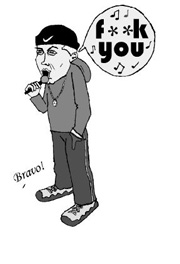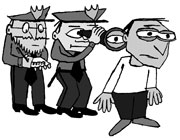One of the reasons the anti -WTO demonstrations in Seattle last fall came as such a shock to the world’s ruling elites was that they called into question economic assumptions that have largely gone unchallenged in the First World for the last 50 years. The WTO is a relatively new institution, and it carries with it broad new powers for corporate rule; but the basic idea that public policy should be subservient to the needs of capital has been inflicted wherever possible since the close of World War II.
Now the two international institutions most associated with neoliberalism—the idea that economic development is best accomplished by lowering tariffs, slashing social spending, and welcoming foreign investment—are in line for the Seattle treatment. The next major mobilization of the anti-corporate-globalization movement comes next weekend, April 16 -17, in Washington, DC. The International Monetary Fund (IMF) and the World Bank are jointly holding spring meetings at the IMF headquarters in DC, and the protesters are promising to shut the meetings down. Arrayed against them is a small army of 1,400 DC police, buttressed by numerous other federal law enforcement agencies, all determined not to let the debacle of the Seattle experience be repeated.
The lines for the DC protests are much more clearly drawn than in Seattle. The IMF (short-term international loans) and the World Bank (long-term development projects) have a 50-year track record of trying, fruitlessly, to promote economic development in the Third World, and trying, successfully, to promote corporate exploitation of the Third World. For several decades the IMF’s demand in exchange for international credit has been that recipient governments adhere to a strict regimen of Reaganesque “structural adjustment” programs: currency devaluation, tariff abolition, extensive reduction of social programs, and tax breaks for foreign investment. The resulting hyperinflation and unemployment tends to lead to anti -IMF riots and social chaos, which in turn results in government crackdowns designed to please foreign investors and resource extractors who like a desperate work force and an obedient, malicious military. In short, the IMF is economic colonialism at its ugliest: good for the elites, bad for everyone else.
The IMF and the World Bank claim to be dedicated to the economic improvement of the underdeveloped world, but their record in this regard is dismal. Over the past several decades the global gap between the economic haves and have-nots has widened, not shrunk. The long-term debt created by World Bank -sponsored boondoggle projects in the ’60s and ’70s has led to insurmountable foreign debts to First World banks. (Hence the call by Jubilee 2000, present at both Seattle and DC, for cancellation of foreign debts owed by the world’s poorest countries.)
Anarchists, cops, and windows
The DC demonstrations will be very different from Seattle in at least a couple of ways, and as such they’ll pose a major test of the viability of the movement to which Seattle gave birth. Unlike Seattle, where at least half of the 50,000 or so protesters came from the Seattle area, almost all of the DC demonstrators will be traveling from other parts of the East Coast or the rest of the country. (Seattle itself is sending at least 100 demonstrators.) It will be a scenario that DC police see quite regularly—national groups coming to town to protest this or that—although they probably haven’t seen some of the West Coast -style direct action tactics before.
Secondly, the activists in DC will be hard-core demonstrators—not just because they’re traveling from elsewhere, but because unlike the WTO, the IMF and the World Bank’s policies don’t directly affect (and thus mobilize to action) most Americans. Whereas the WTO has struck down US laws, the IMF and World Bank primarily benefit US corporations and do most of their harm in the Third World. There’s no personal interest to motivate Middle America to march.
Furthermore, DC police are not going to be caught by surprise, and they’re not operating under any mayoral mandate to let protesters be heard. Chances are demonstrators will not get within several blocks of the meetings themselves. However, tens of thousands of protesters can still gum up the works mightily, and their voices will not easily be silenced.
As in Seattle, the anarchists will also be out in force. Heated Internet discussions have taken place between those who saw Seattle’s window-breaking as counterproductive violence and those who saw it as an inspiring blow against corporatism. Dozens of anarchist groups have publicly stated they won’t abide by the protest sponsors’ nonviolence guidelines, which include a ban on property destruction. There are few upscale businesses in downtown DC, but lots of federal office buildings with windows that will look attractive to an anarchist’s hammer. In turn, expect that any sort of “violence” or “riot” will be used to justify the same sort of violent police crackdowns on nonviolent demonstrators that we saw here. DC cops have stocked up on tear gas, rubber bullets, and other “less-than-lethal” crowd-control measures.
Some protesters are, in fact, very much hoping that DC will be a replay of Seattle. Many see police thuggery as simply an unavoidable consequence of being effective. There’s a kickoff Jubilee 2000 event, a separate labor rally, numerous teach-ins and workshops, a week-long “convergence” space for direct action protesters when they get into town, and an Independent Media Center—all predicated on what “worked” in Seattle. How many people turn out, and how the police respond, will go a long way to determining whether Seattle’s anti -WTO protests were a unique event or the inspirational first battle in a historic new international movement.
Next week: report from DC!







